Against Witness
Paul Celan, Doris Salcedo, and memory in the Internet age
It’s a fact that more artists and writers tailor their works with the Internet viewer in mind. There are artists who make trendy abstract paintings in bold, unmodulated colors so nothing is gained or lost when one sees them on Instagram or in the gallery; these paintings are as easy to apprehend online as a color swatch for a sofa, which is ideal for the collector who doesn’t have time to experience the product in person. Similarly, there are more writers who write with transparent compression, knowing that their phrases could be atomized into tweets, chiseled into self-sufficient, endlessly linkable fragments.
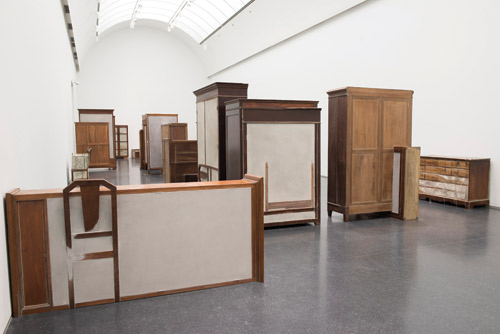
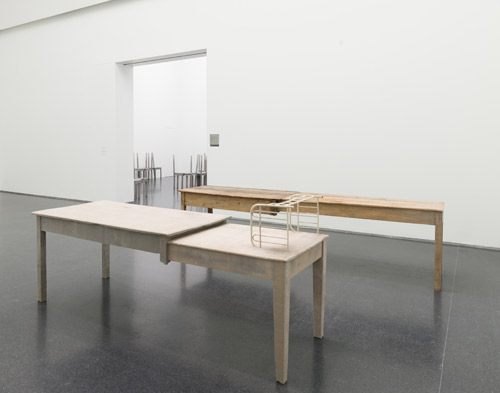
Installation views, Doris Salcedo, Museum of Contemporary Art Chicago, February 21 — May 24, 2015. Artworks are by Doris Salcedo. Photographs are by Nathan Keay, © Museum of Contemporary Art Chicago.
But Doris Salcedo is not that kind of artist. She makes installations that resolutely resist this age of digital reproduction. Installation art is an immersive somatic experience, engaging all our perceptual planes — the spatial, the aural — and not just the optical. You have to be there in person to truly apprehend the art. Installations can be a ritualized quasi-religious experience, shimmering with Walter Benjamin’s famous notion of aura. If there is monumental labor involved, there can be something unseemly and decadent about installation art because of its temporality. It is wasteful because it cannot be kept.
Salcedo’s sculptures are anti-monumental. She works with humble domestic objects like wooden wardrobes, chairs, and tables that are sparely arranged in an exhibition space. Inspired by Paul Celan, she repeatedly refers to his poetry in her titles, like Unland: audible in the mouth, Shibboleth, and Unland: the orphan’s tunic. The objects are all used, rubbed down and softened by the bodies that have handled, lain, and sat on them for years. Chairs are dismembered, embedded into long, narrow doors; dining tables are ripped from their context, denuded of accompanying chairs, and can resemble morgue tables. These furnitures are ruins, sepulchral. A chair encased in poured concrete looks as sunken as if it were on the bottom of an ocean floor. A frail upended crib looks volcanized or rescued from the ashes of a fire. But the surfaces have been manipulated by the artist’s hand: table surfaces have been distressed, scratched, and threaded with human hair like cryptic inscriptions from the dead.

Untitled, 1998, wooden cabinet, concrete, steel, and clothing, 72 1/4 x 39 x 13 in. Collection of Lisa and John Miller, fractional and promised gift to the San Francisco Museum of Modern Art.
Salcedo’s installations are said to be intimate and uncanny, both qualities in an artwork that must be intuited in person because both qualities require proximity. You must inhabit a space to feel uninhabited by the uncanny. In German, uncanny is unheimlich, or its literal translation, unhomely. To feel the uncanny is not unlike déjà vu, where you are in a new environment and are jolted by a flash of the familiar, or inversely, when you’re in your own home and you suddenly feel a terrible unease that this is not your beautiful house. Freud said that flash of the familiar is a return of our repressed past. It is the opposite of Kant’s notion of the sublime: while one elicits a rush of elevated pleasure, the uncanny provokes anxiety, a discomfort in one’s own skin. The uncanny, according to Freud, is not unlike the feeling of being buried alive. The uncanny, according to Freud, is also to feel “robbed of one’s eyes.”
Salcedo has called herself a “secondary witness.” She has made sculpture responding to the 1988 massacre of La Negra and La Honduras banana plantations, where workers were dragged out of their beds and shot in front of their families. She has made sculpture responding to a story of a six-year-old orphan who, after witnessing the killing of her mother, wore the dress that her mother sewed for her day after day. Salcedo combs the countryside of her native Colombia, searching and listening to victims whose family members have “disappeared” because of the ongoing violence between drug traffickers and right-wing paramilitary groups.

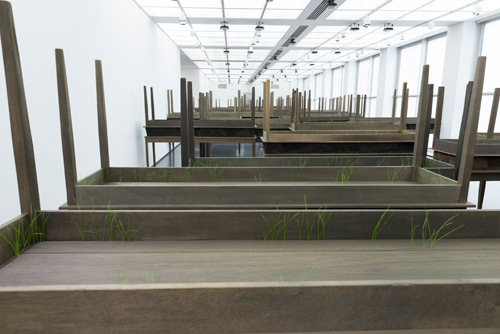
Untitled (detail), 1998; Plegaria Muda (detail), 2008–10, wood, concrete, earth, and grass, one hundred and sixty-six parts, each 64 5/8 x 84 1/2 x 24 in., overall dimensions variable. Inhotim collection, Brazil.
To make art representing another victim’s pain can be ethically thorny. Susan Sontag wrote, “The appetite for pictures showing bodies in pain is as keen, almost, as the desire for ones that show bodies naked.” Images of suffering can arouse our horror, simulating an illusive identification between us and the victim or “a fantasy of witness” before we are conveniently deposited back into our lives so that someone else’s trauma becomes our personalized catharsis.
But Salcedo refuses our appetite for the sanguinary, refuses any attempt at verisimilitude because what is absent in her work is the body in pain. Tragedy has not been transmuted into a consumable narrative or embedded into an instant, catch-all image. There is a somber restraint to her artwork, a silence; these stories she’s gathered cannot be represented. Said Salcedo: “I have constructed the work as invisibility, because I regard the non-visual as representing a lack of power. To see is to have power; it’s a way of possessing.”
•
Like Salcedo’s art, Celan’s poetry is often characterized as “bearing witness,” a description that has become a genre unto itself. All poems bear witness, even if it’s to the dailiness of one’s life — like going to the movies or stealing plums from the icebox — but a poem valorized as such is a poem that is testimony to an exceptionally dark period, embalming a moment where there has been visible, collective trauma. Oftentimes, the poet has witnessed catastrophic conditions that have happened elsewhere in a geographically remote place (quite a few poets categorized as witness poets happen to be Eastern European) or conditions that have already been bookended in the past. It’s rare that these conditions are chronic systemic problems like income disparity. The critical reception surrounding the poem that bears witness is rife with moral earnestness: the poem is about survival; the poem fights against oblivion; the poem calls for hope; and ultimately, the poem remembers.

Plegaria Muda (detail), 2008–10.
But is it enough that a poem “remembers” when we are now entrenched in an era of total recall? Andreas Huyssen wrote, “Everything is stored in the cloud. There is endless memory. From the point of the view of the archive, forgetting is the ultimate transgression.” According to Huyssen, we suffer from a hypertrophy of memory. Like Beyoncé, who records every minute of her life, we have amassed archives so thorough that real time is cannibalizing present time. So why valorize poetry for being a living archive when memory has become our most booming industry? In an era when eyewitness testimonies, photos, and videos are tweeted seconds after a catastrophe, poetry’s power to bear witness now feels outdated and inherently passive.
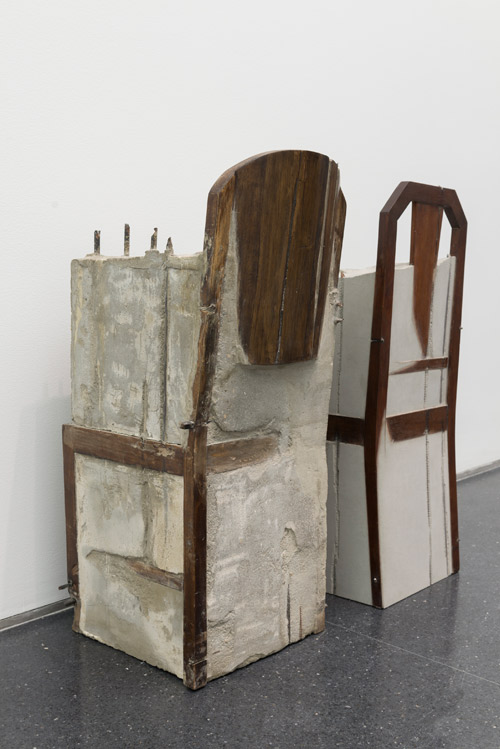
Installation view, Doris Salcedo, Museum of Contemporary Art Chicago.
But perhaps I feel this way since I’m writing this when the witness seems more powerless than ever. There were sixty-four witnesses when the grand jury reviewed the murder of Michael Brown, yet still the grand jury failed to indict police officer Darren Wilson. With the case of Eric Garner, there was a cell phone recording of the fatal chokehold. “The grand jury kept interviewing witnesses, but you didn’t need witnesses,” Garner’s widow said of the video to the New York Daily News. “You can be a witness for yourself.” We were all witnesses. We all saw. Yet witness accounts matter little when prosecutors can mishandle evidence and mislead the jury, when evidence is up against the Law that makes impossible the criminal conviction of police officers who act with impunity. When the verdict was announced, one felt robbed of one’s eyes.
•
During Celan’s lifetime, critics lauded his “Death Fugue” as being an irrefutable poem that bore witness to the Holocaust. Out of all his poems, “Death Fugue” was the most anthologized and the most quoted for its haunting, incantatory power and its clear references to the concentration camps. As his poetry became more idiosyncratic — his syntax more gnarled, his images more gnomic and mineralogical, his syllables more neologistic — Celan grew to loathe “Death Fugue.” It dogged him, overshadowing his other works, and fearing he was becoming a mouthpiece for Jewish Holocaust poetry, Celan later refused to let “Death Fugue” be further anthologized. Meanwhile, “Death Fugue” became a German obsession, a fixture at commemorative events. The scholar Sidra DeKoven Ezrahi wrote,
At some subliminal level the Germans have come to know the poem ... at such an early age and on ceremonial occasions that it has become an incantational procedure rather than an intended text.
Rather than an act of rememberance, the recitation of “Death Fugue” turned into a mantra to ward off difficult engagement with the past. But this is how it is when a poem becomes commemorative. It becomes all pious gesture and drained of meaning. When a poem becomes commemorative, it dies.
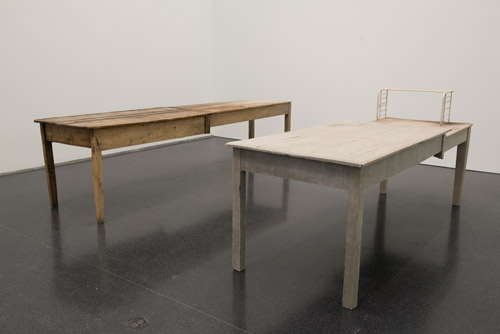
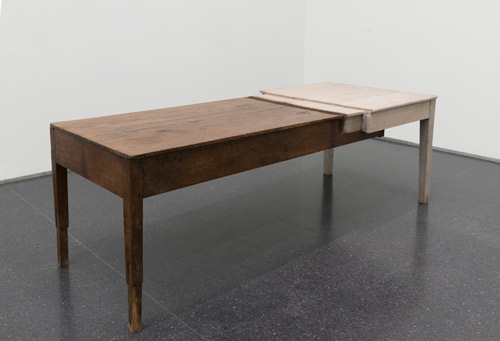
Installation view, Doris Salcedo, Museum of Contemporary Art Chicago; Unland: the orphan's tunic, 1997, wooden tables, silk, human hair, and thread, 31 1/2 x 96 1/2 x 38 1/2 in. “La Caixa” Contemporary Art Collection.
Whatever word you speak —
you owe to
destruction.
Celan was not just a poet who bore witness. Celan was a visionary poet — and also a vengeful poet. Pierre Joris, who translated the impressive Breathturn into Timestead: The Collected Later Poetry, writes how Celan’s poetry creates “in and through the poems a new, viable world.” Joris also cautions that we not limit Celan’s poetry to a “revenge play,” but I don’t consider it a limitation. Like the artwork of witness, the artwork of vengeance could be its own genre (see Kim Hyesoon, see Kara Walker, see Dodie Bellamy). Celan was full of what Nietzsche called ressentiment — which is a slave’s sensibility of grievance, paranoia, and defiance — and turned it into a fecund creative force. This is the kind of literature that is lifeblood against the sanctimonious, sanctioned poetry that the establishment uses to exonerate themselves. It is not enough for a poem to be witness, to preserve a dated moment and give voice to puppets from the past. It’s not enough that a poem extol the virtues of survival and overcoming. What if the poet never overcomes? What if the poet hears the same bitter verdict when testimony after testimony has been given? What if that poet — and this is the ultimate emotional transgression that repels the reader who takes comfort in literature as forgiveness — still feels a shadow of hate and it is that hate that disfigures song into something broken? But see, the only way to get at that inalienable grief is to disfigure song. Celan was a sadist with the German language, shredding it down to find the kernel, and from those shreds, he created a third language:
Black
as memory’s wound
the eyes root for you
in this plot bitten
bright by the heart-teeth.
He wrote from negation, from an “eternalized Nowhere,” from an identity of “no name,” countering with the impossibility of testimony since testimony could be easily manipulated and excerpted into soundbites. His language is irreducible. It is stone and ash. It is the soundless howl that tears at the enemy’s syllables until they are spent shells.
No one
bears witness for the
witness.
To give form to memory, one must also forget. Like Celan’s poetry, Salcedo’s sculptures ignite silence. Her installations slow down perception. They require that I be there in person and that I see with my body, a mode of perception that grows obsolescent as the culture industry razes down time and space into the cloud. The actual presence of I, the viewer, is required to truly apprehend the absence of you, the Other. These domestic ruins have been rafted from nowhere, from no one. I cannot sit in your chair, eat at your table. I cannot open your dresser and touch your shirts that will trigger eidetic memories of a dance or late night walk. The proximity between you and me is infinite. (And what kind of proximity do I need to write as witness? Should I have experienced the event myself? If I watched the video, can I write about it? Do I have to be related to the victim? And what do you mean by relation?) I can never metabolize what you went through yet I cannot escape your disquieting sadness, the burden of your solitude. How it unfolds even when I leave this space. What has become of you? What could have gone through your mind?
Cathy Park Hong is the author of poetry collections Engine Empire (2012); Dance Dance Revolution (2007), winner of the Barnard New Women Poets Prize; and Translating Mo'um, (2002). Hong's memoir and cultural critique Minor Feelings: An Asian American Reckoning (2021) was a finalist for the Pulitzer Prize. She is the recipient of fellowships from the Fulbright Foundation, Guggenheim, the NEA, and the...


